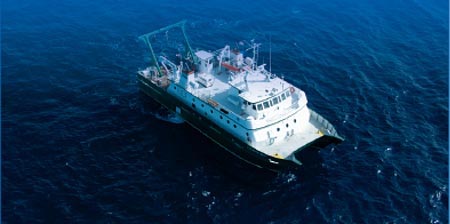Two very useful such tracers are radiocarbon (14C) and tritium (3H). The ranges of activities per liter of seawater in the ocean are about 0.3 dpm (disintegrations per minute) for 14C and 0 to 20 dpm for 3H, i.e., extremely low by any standard. The isotopes in question are also manufactured and used in relatively large quantities (as 14C-tagged carbonate, tritium-tagged organics) for the study of primary production and other biochemical studies. These “artificial” isotopes are used on board the ship in quantities of up to 1011 times the detection limits needed for the study of the natural distribution of the isotopes in the ocean. Thus, even a minute spill, even if many orders of magnitude lower than any health-related levels, would be entirely disastrous for the natural tracer projects.

Conventional testing done by radiation control groups would not be sensitive enough to detect levels that could contaminate natural tracer experiments. This was why this “SWAB” program was started in 1981. In this program, we use a much more sensitive method to test areas on board research vessels that may have been exposed to radioactive spills, especially of 14C and 3H. We also give advice on cleaning up of spills. The very sensitive detection levels that we achieve with the SWAB program not only give a better chance for a natural tracer program to succeed, but also it turns out to be of great benefit to the attitude of the ship crews. They know that with our extremely sensitive testing for radioactive spills, they can rest easier knowing that there is no hidden radioactive contamination.
A SWAB test should be conducted after every cruise that involves the use of 14C or 3H. Please contact the Tritium Lab at 305-421-4119 or tritium@rsmas.miami.edu to request a SWAB test.




